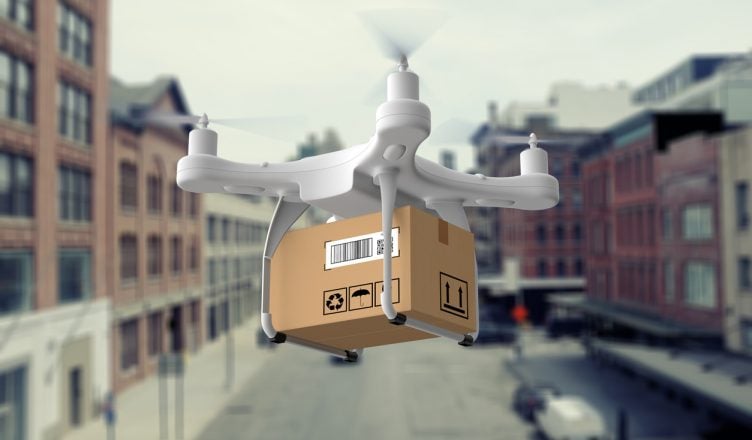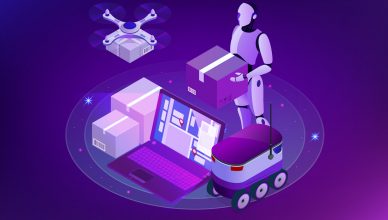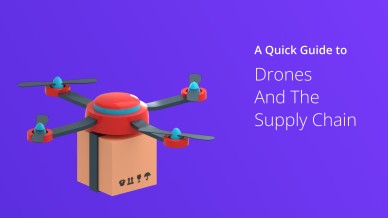While being social is a natural instinct of mankind, it has become dangerous since the COVID-19 outbreak, increasing the risk of spreading the disease. So, social distancing has become the new norm for the entire world. Yet, people still need certain essential items to survive, despite maintaining lockdown and public health measures. These need to be delivered to people’s homes.
In-person delivery would increase the risk of spreading the disease and thus companies and logistics providers are gradually realizing the potential of drone delivery services. But, while drones can be considered a solution, there are certain questions too that need to be answered.
Benefits of Drone-Based Delivery
With America under complete lockdown, the citizens are mostly dependent on doorstep delivery of essentials. Yet, such doorstep delivery of sustenance goods, for example, groceries, medicines, baby food, and toiletries, normally relies on commercial fleets and manpower and has been greatly affected by the Coronavirus pandemic.
For example, a worker offering these essential services risks being infected with and spreading the virus from person to person. And the virus is claiming lives at a horrific rate globally. In fact, delivery giants like Amazon have reported constant recruitment of delivery people as others keep testing positive for COVID-19.
At this time, an unmanned aircraft system could be a solution and thus commercial drone delivery is being identified increasingly as a savior. The use of drone technology, which has thus far been limited to small deliveries (mostly for medical deliveries), aerial photography, law enforcement, and military operations, is now increasingly being adopted by grocery delivery companies.
Consequently, US logistics is witnessing a surge in demand for consumer drones to drop delivery packages at customer addresses. This has contributed to an upward curve for drone manufacturers and drone service provider companies as well as for retailers amidst the bummed economy.
Want To See For Yourself How Route4Me Can Boost Your Profits?

The Savior in Crisis
Google’s parent company, Alphabet, started its drone delivery service, Wing, in April 2019 in Australia. Soon after, the US Federal Aviation Administration (FAA) issued them a federal air carrier certificate to operate legally in the US. So, America saw Wing’s testing of shipments in rural Christiansburg in October. According to Bloomberg reports, the Virginian town has recorded doubled delivery figures, while rural Virginia witnessed a dramatic increase in customer growth in this pandemic.
Alphabet’s drone delivery focuses on companies that lack the resources to deliver goods to housebound customers. To better serve the Americans stuck at their homes, Wing has increased its number of vendors and expanded its existing collaborations as well. So, it is reportedly actively home-delivering groceries, baby food, cookies, coffee, and toilet paper and has experienced a massive jump, crossing the milestone of over 1,000 deliveries in just two weeks.
Wing is also helping local businesses flourish during this crisis. Mockingbird Café, a local café, has recorded a rise in sales of its pastries by 50% on the first weekend of collaboration with Wing. Brugh Coffee, another local business, also saw its sales of cold brew double since Wing started its delivery.
Thus, Wing’s services have benefited both the customers and the delivery companies which deliver groceries, medicines, and other essentials to customers during the lockdown.
Drone delivery to me & my dog at home. My 8-month-old Labrador was unperturbed by the drone, but curious and eager to go fetch the package (dog food?). The delivery was from Walgreens via @Wing, & arrived 5 minutes after placing the order. #logistics #dronedelivery #covid19 #dogs pic.twitter.com/0zPqe6TsYH
— Shane Ross (@RossDynamicsLab) April 10, 2020
Following suit, Flytrex, an Israeli startup has introduced its drone service in Grand Forks, North Dakota on April 24, 2020. Its delivery services will include contactless food delivery from restaurants, medicines from pharmacies, and other goods from retailer partners.
Players in the Drone Market
Drone delivery leaders like Wing and UPS Flight Forward regularly conduct drone delivery trials for food, medical requirements, retail products, and industrial goods. Also, behemoths like Walmart, Amazon, and DHL use drones for internal business requirements.
To ensure frictionless last-mile delivery and carry this forward profitably, efficient route planning is required. So, an advanced route planner like Route4Me can be of great help as it can help with accurate drone route optimization, with the addresses and drone capacities plugged in. Route4Me can even help customize the behavior of the drones. For example, you could set it up so that your drones perform a particular maneuver when they reach a specific altitude, define capacity constraints, and set a maximum route length to establish a point-of-no-return distance.
Hazards to Sort
During the COVID-19 pandemic, while the economy is bent out of shape, drone delivery services have picked up momentum in the case of common goods, meeting the needs of essential delivery to households while avoiding the risks of human contact and spreading the virus further. Even though the enhanced capacity and increased usage of commercial drones seem to be beneficial in this crisis, the major surge of drone delivery usage calls for a reconsideration of government regulations regarding drones as well as for settling some prevalent issues:
- Carrying one delivery package at a time, drones use 10 times more fossil fuel than an electric delivery van. This is because drones require constant energy, while a vehicle can be parked and turned off when necessary.
- Drones’ limited capacity of delivery would require frequent back-and-forth trips, which a van might complete by a single trip as it can carry multiple packages. This would lead to an unnecessary waste of time when delivering multiple packages in a particular area.
- Frequent back-and-forth journeys will also be costly for the delivery company.
- Crosswinds and headwinds, while hovering around and waiting for customers, can also lead to higher energy consumption.
In the Times to Come
Shifting from delivering lab samples or other medical requirements, many drone service providers would definitely be keen to serve as delivery services of essentials in the future. The changing needs would require the above issues to be addressed well in terms of the evolving drone technology. The future of drone delivery also looks forward to changes in regulations and approvals from governments.
Want To See For Yourself How Route4Me Can Boost Your Profits?



